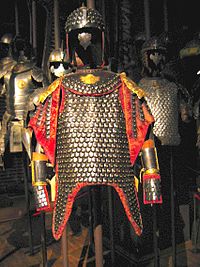
Back Sarmatisme Afrikaans Сарматызм Byelorussian Sarmatismus Czech Sarmatismus German Sarmatismo Spanish سرمتیگرایی Persian Sarmatismi Finnish Sarmatisme French Szarmatizmus Hungarian Sarmatismo Italian



Sarmatism (or Sarmatianism; Polish: Sarmatyzm; Lithuanian: Sarmatizmas) was an ethno-cultural identity within the Polish–Lithuanian Commonwealth.[1] It was the dominant Baroque culture and ideology of the nobility (szlachta) that existed in the time from the Renaissance to the early 18th century.[1] Together with the concept of "Golden Liberty", it formed a central aspect of the Commonwealth social elites’ culture and society. At its core was the unifying belief that the people of the Polish–Lithuanian Commonwealth descended from the ancient Iranian Sarmatians, the legendary invaders of contemporary Polish lands in antiquity.[2][3]
The term and culture were reflected primarily in 17th-century Polish literature, as in Jan Chryzostom Pasek's memoirs[4] and the poems of Wacław Potocki. The Polish gentry wore a long coat, called kontusz, knee-high boots, and carried a szabla (sabre), usually a karabela. Moustaches were also popular, as well as decorative feathers in men's headgear. Poland's "Sarmatians" strove to achieve martial skill on horseback, believed in equality among themselves, and in invincibility in the face of the enemy.[5] Sarmatism lauded past victories of the Polish military, and required Polish noblemen to cultivate the tradition.
Sarmatia (Polish: Sarmacja) was a semi-legendary, poetic name for Poland that was fashionable into the 18th century, and which designated qualities associated with the literate citizenry of the vast Polish–Lithuanian Commonwealth. Sarmatism greatly affected the culture, lifestyle and ideology of the Polish nobility. It was unique for its cultural mix of Oriental, Western and native traditions. Criticized during the Polish Enlightenment, Sarmatism was rehabilitated by the generations that embraced Polish Romanticism. Having survived the literary realism of Poland's "Positivist" period, Sarmatism made a comeback with The Trilogy of Henryk Sienkiewicz, Poland's first Nobel laureate in literature.
- ^ a b Kresin, O. Sarmatism Ukrainian. Ukrainian History
- ^ Tadeusz Sulimirski, The Sarmatians (New York: Praeger Publishers 1970) at 167.
- ^ P. M. Barford, The Early Slavs (Ithaca: Cornell University 2001) at 28.
- ^ Pamiętniki Jana Chryzostoma Paska [1690s] (Poznan 1836), translated by C. S. Leach as Memoirs of the Polish Baroque. The Writings of Jan Chryzostom Pasek (University of California 1976).
- ^ Simon Schama, Landscape and Memory Vintage, New York, 1995:38.